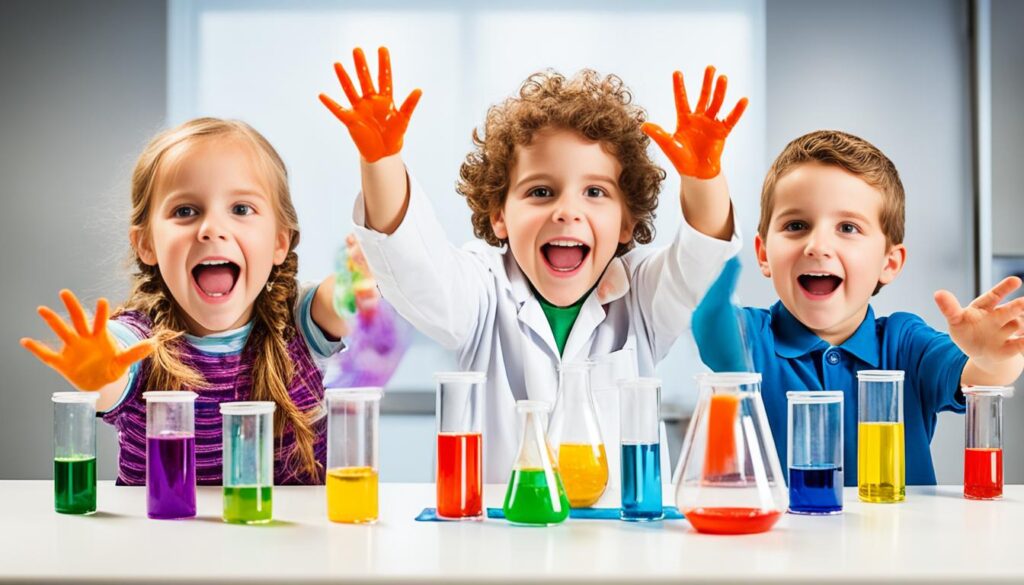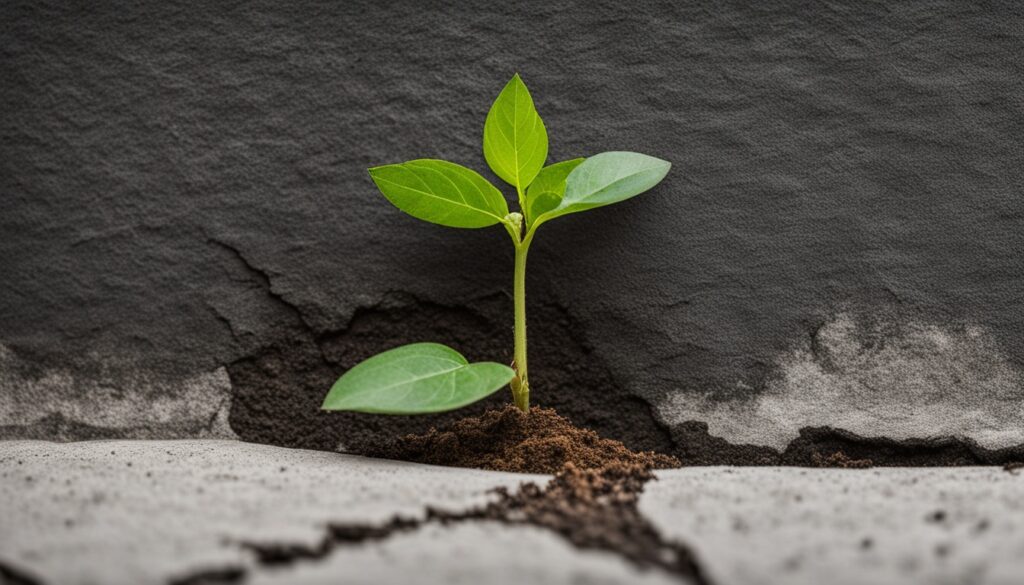In today’s fast-changing world, thinking critically is key. Science helps teachers teach this important skill. It uses observation, experiments, and evidence to help students think better.
By doing hands-on science projects, students learn to question things, make guesses, and look at data closely. This helps them understand science better and keeps them curious. It also teaches them to solve tough problems, think outside the box, and make smart choices.
Science also makes students work together and learn from each other. They share ideas, question each other, and solve problems as a team. This helps them see different points of view and share their thoughts clearly.
This article will show how science can boost critical thinking in class. We’ll talk about how to design interesting experiments and build a mindset for growth. We’ll see how science can help students reach their full critical thinking potential.
Unleashing the Power of Scientific Inquiry
Learning to love scientific inquiry is key to developing critical thinking skills. By encouraging students to ask questions, we spark their curiosity. This leads them to explore the world more deeply.
Fostering a Questioning Mindset
Starting with thought-provoking questions is the first step in teaching scientific inquiry. When students question what they know, they learn to think critically. This mindset helps them in all their studies.
Embracing Curiosity and Exploration
Science is about discovery. By valuing curiosity and exploration, teachers inspire students to delve deeper into science. Hands-on experiments and open-ended projects let them follow their interests. This builds a strong love for critical thinking in science that lasts.
By teaching a questioning mindset and valuing curiosity and exploration, teachers can fully unlock scientific inquiry. This prepares students to be critical thinkers ready for the future.
The Scientific Method: A Framework for Critical Thinking
The scientific method is a strong way to improve critical thinking skills. It’s a step-by-step process that helps students solve problems with logic and evidence. This method is useful in many areas of life.
It starts with making hypotheses and designing experiments to test them. Then, students collect and analyze data to reach conclusions. This method teaches students to question assumptions and make choices based on facts.
Through the scientific method, students learn to tackle complex problems step by step. They test their ideas and improve their understanding through learning cycles. This approach builds curiosity, problem-solving skills, and critical thinking.
The scientific method is key for exploring the world and solving tough classroom problems. It helps students develop skills needed for the 21st century. By using this method, students can think deeply, reason scientifically, and solve problems with confidence.
Hands-On Experiments: Engaging the Senses
Hands-on experiments are key to building critical thinking skills. They let students dive into the scientific method. This way, they get to touch, see, and feel science in action.
Students learn by designing experiments, testing hypotheses, and analyzing data. This hands-on method makes science real and meaningful for them.
Designing Experiments to Test Hypotheses
Testing hypotheses is a big part of science. Hands-on experiments are perfect for this. Students can create their own experiments, pick variables, and collect data.
This approach strengthens the scientific method and boosts critical thinking. Skills like problem-solving and using evidence become more important.
Observing, Recording, and Analyzing Data
During hands-on experiments, students get to see science happen right before their eyes. They record their findings and the data they gather. Then, they analyze it to draw conclusions.
This process is key for critical thinking. Students learn to spot patterns, trends, and make smart guesses based on evidence.

Hands-on experiments are not just fun; they spark curiosity and critical thinking. They prepare students for success in science and other areas. By taking part in the scientific method, students gain a deeper understanding of science and develop important skills.
Challenging Assumptions and Biases
When we think critically, we must question our own beliefs and the biases that shape our thoughts. By doubting our initial thoughts and those of others, we can think more objectively. This leads to better problem-solving and decision-making.
Recognizing and Overcoming Cognitive Biases
Cognitive biases are shortcuts in our minds that can lead to irrational decisions. Knowing about biases like confirmation bias or the availability heuristic helps us fight them. By being aware of these biases and seeking out different views, we can improve our scientific thinking.
Activities like playing devil’s advocate or looking at things from another perspective can help us avoid our biases. Encouraging students to question their and others’ beliefs promotes curiosity and openness. This strengthens their critical thinking abilities.
As we learn about scientific reasoning, it’s key to be open to changing our minds. By questioning our beliefs, we gain a deeper understanding of the world. This leads to more informed decisions based on evidence.
Science in Real-Life Scenarios
Using science in everyday life is crucial. Teachers show students how science helps solve real problems. This makes science more meaningful and useful.
Applying Scientific Reasoning to Everyday Situations
Fixing a broken appliance or understanding health trends requires critical thinking. By using science, people can make better choices and solve daily challenges. Students learn to observe, guess, test, and analyze to solve problems.
Science helps us understand the effects of products, predict the weather, and make smart money choices. It turns people into better consumers, citizens, and problem-solvers. Teachers show students how science applies to many areas of life, making them more capable in today’s world.
Cultivating a Growth Mindset through Science
In the science classroom, it’s key to build a growth mindset. Teachers should make students see challenges and failures as chances to learn and get better. This mindset helps students think deeply, solve problems, and succeed in life.
Science is perfect for building a growth mindset. Through experiments, students learn from their mistakes. They learn to analyze data, question assumptions, and think deeply about the world. These skills are vital for a growth mindset.

By teaching a growth mindset in science, teachers prepare students for success. When students aren’t scared to try new things and ask questions, they solve problems better. This leads to better critical thinking, perseverance, and adapting to change. These are key skills for doing well in today’s world.
The Role of Science in Developing Problem-Solving Skills
Science education is key in teaching problem-solving skills. These skills are crucial for dealing with today’s complex world. By learning science, students learn to tackle challenges with a clear and analytical mind. This helps them break down complex problems and find solutions.
Breaking Down Complex Problems Systematically
The scientific method is the core of scientific inquiry. It gives a clear way to solve problems. Through science, students learn to make hypotheses, design experiments, collect and analyze data, and draw conclusions.
This method helps them turn complex problems into simpler steps. It boosts their critical thinking and problem-solving skills. These skills are useful in many areas of life.
Science education makes students question assumptions and challenge the usual ways of thinking. This mindset, along with the problem-solving skills learned in science, prepares them to face challenges with creativity. Science education sets the stage for a lifetime of solving problems in school, work, and life.
Encouraging Critical Thinking through Science Education
In today’s fast-paced world, critical thinking is key. Science education is a big part of this. By using inquiry-based learning, teachers help students become active learners. This helps them solve problems they’ll face in the future.
Incorporating Inquiry-Based Learning Strategies
Inquiry-based learning makes students ask questions and design experiments. They collect and analyze data and draw conclusions. This is what critical thinking is all about.
By letting students lead their learning, they become more curious and understand science better. When they’re involved in learning, they remember more and use what they know in real life.
Hands-on experiments and open-ended investigations teach students to think deeply. They learn to question assumptions and find new solutions. This way, they get better at critical thinking and working together to solve problems.
Using inquiry-based learning in science education helps students think for themselves. They become more confident and ready for the 21st century. This method boosts critical thinking and makes students excited about science and discovery. It changes how they learn and live.
Fostering Collaboration and Peer Learning
Science education is more than just learning alone. It’s about working together and sharing ideas. By doing this, students get better at thinking critically, solving problems, and communicating well.
Teamwork is key in science, where complex problems need many different views. When students work together, they get a deeper understanding of science. They also improve at listening, negotiating, and compromising. These skills help them do well in school and later in life.
Peer learning is another great way to teach science. Students teach and learn from each other. This helps them explain their thoughts, question each other, and give feedback. It makes them more curious and respectful of each other’s ideas. This way, they get a better grasp of science and are ready for the teamwork needed in scientific research and discovery.



